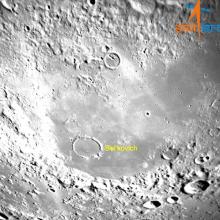Listen to today's episode of StarDate on the web the same day it airs in high-quality streaming audio without any extra ads or announcements. Choose a $8 one-month pass, or listen every day for a year for just $30.
You are here
New Moon
This would be a great day to stand on the Earth-facing side of the Moon. That’s because there’s a full Earth in the sky. Our planet is almost four times the diameter of the Moon, so a full Earth looks much bigger than a full Moon. And Earth reflects an average of about three times more sunlight than the Moon does. Put those numbers together, and a full Earth shines more than 40 times brighter than a full Moon -- a spectacular sight in the lunar sky.
On the other hand, from Earth, we can’t see the Moon at all. That’s because it’s “new” today -- it crosses the line between Earth and the Sun. It appears close to the Sun, so it’s hidden in the Sun’s glare.
The only time we do see the new Moon is during a solar eclipse -- when the Moon passes directly in front of the Sun, blocking all or part of its light.
The Moon crosses the Earth-Sun line about once a month. But the Moon’s orbit around Earth is tilted. Most months, the Moon passes above or below the Sun. Two or three times a year, though, the geometry is just right, creating an eclipse.
The next one is coming up on October 14th, and it’ll be visible across most of North America. The Moon will be farther from Earth than average, though, so it won’t completely cover the Sun’s disk -- a ring of sunlight will encircle the Moon. The next total eclipse will take place in April. It, too, will be visible from North America -- a spectacular sight from Earth and the Moon.
Script by Damond Benningfield






